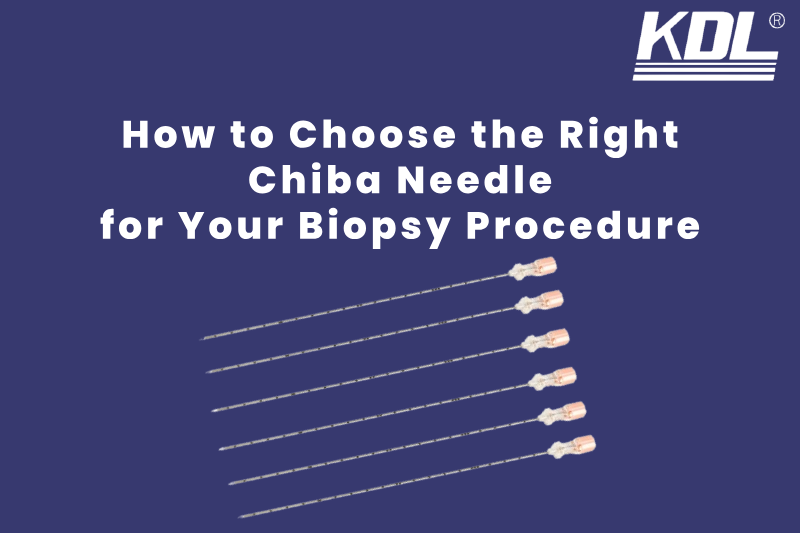
When performing a biopsy, the precision and safety of your tools can make a significant difference in the outcome. One of the most important instruments in this procedure is the Chiba needle. A Chiba needle for biopsy is specifically designed for precise needle of soft tissues and organs, commonly used for diagnostic procedures such as liver, kidney, or lung biopsies.
Choosing the right Chiba needle is crucial for a successful biopsy and patient safety. In this article, we will guide you through the how to choose the right Chiba needle for your biopsy procedure.
What is a Chiba Needle?
A Chiba needle is a thin, hollow needle used to extract a small sample of tissue for diagnostic testing. It’s design for use in procedures that require precision, such as biopsy, where obtaining an accurate sample is crucial for accurate diagnosis.
The needle has a unique structure, often featuring a sharp tip for easy tissue penetration and a lumen (hollow center) to collect the tissue sample. Some Chiba needles are equipped with a stylet to maintain the needle’s shape and prevent clogging during insertion.
Why Choosing the Right Chiba Needles Matters
Choosing the high quality Chiba needle can influence the quality of the biopsy sample , patient comfort, and procedure efficiency . An inappropriate needle can lead to several issues, such as:
- Poor-quality samples: If the needle is too thick or the tip is too blunt, it can cause excessive tissue trauma, leading to poor-quality samples that may not be useful for diagnosis.
- Increased risk of complications: A needle that’s too large or incorrectly sized for the procedure can increase the risk of bleeding, organ damage, or infection.
- Patient discomfort: A poorly selected needle may cause more pain or discomfort during the procedure, making it harder to perform and less comfortable for the patient.
Whether you’re using a Chiba needle for lung biopsy or a Chiba aspiration needle for liver tissue, proper selection ensures better diagnostic outcomes and less procedural risk.
Factors to Consider When Choosing a Chiba Needle for biopsy
Several factors can affect the outcome of your biopsy, and each one should be considered when choosing the right Chiba needle.
1. Needle Size and Gauge
The size and gauge of the Chiba needle are essential to ensure an accurate biopsy sample without causing unnecessary harm to the tissue. The gauge refers to the thickness of the needle, with a higher number meaning a thinner needle.
- Smaller needles (higher gauge) are often use for delicate tissues and areas
- Larger needles (lower gauge) may be necessary for tougher tissues or for sampling larger amounts of tissue, such as lung biopsies.
The size of the needle should match the procedure, as using a needle that’s too large or too small can lead to complications. For example, using a needle that is too thick could cause excessive bleeding or bruising.
2. Needle Length
The length of the Chiba needle depends on the location and depth of the target tissue. Biopsy procedures often require precise navigation to avoid damaging surrounding tissues or organs.
- For superficial biopsies, such as those taken from skin or subcutaneous tissue, a shorter needle may suffice.
- For deep tissue biopsies, such as those from the liver, kidney, or lung, a longer needle is require to reach the target tissue safely.
Make sure to choose a needle that can reach the target site without the need for multiple insertions, improving procedure efficiency.
3. Needle Tip Design
The tip design of the Chiba needle plays a critical role in the ease of insertion and the quality of the sample collected. Common tip types include:
- Cutting tip: These needles have a sharp, beveled edge, making them suitable for cutting through tissue with minimal force. They’re ideal for procedures that require small, precise tissue samples.
- Non-cutting tip: Some Chiba needles come with blunt or non-cutting tips, typically used for aspiration or when obtaining fluid rather than tissue.
Choosing the right tip design ensures the needle can easily navigate the tissue and obtain a clean sample with minimal trauma.
4. Material and Durability
Most Chiba needles are made from stainless steel, which offers durability and strength, allowing the needle to withstand the pressure of insertion and the biopsy procedure. Make sure to choose a needle that’s not only strong but also flexible enough to bend slightly without breaking, which can be important for procedures requiring a delicate touch.
5. Single vs. Double Lumen Needles
Some Chiba needles come in single lumen or double lumen designs. A single lumen needle has one hollow channel for the biopsy sample, while a double lumen needle has two, allowing you to take multiple samples without having to withdraw the needle.
- Single lumen needles are simple and are often sufficient for basic biopsy procedures.
- Double lumen needles may be more suitable for cases where multiple samples are need from the same site
6. Needle Coating
Some Chiba needles are coated with a special material, such as silicone, to reduce friction during insertion. This can make the procedure smoother and help the needle pass through tissue with less resistance, which is particularly helpful when dealing with dense or tough tissues .
Choosing the Right Types Needle for Specific Biopsy
The right Chiba needle will depend on the type of biopsy being performed. Here’s a quick overview of the considerations for specific biopsies:
| Biopsy Type | Suggested Gauge | Needle Length | Notes |
|---|---|---|---|
| Liver biopsy | 18G–22G | 15–20 cm | Use imaging guidance |
| Lung biopsy | 18G–20G | 20–25 cm | Longer needle required |
| Kidney biopsy | 16G–18G | 18–20 cm | Requires cutting tip |
| Thyroid biopsy | 22G–25G | 10–15 cm | Fine-needle preferred |
| Prostate biopsy | 18G–22G | 15 cm | Consider coaxial system |
Make sure to tailor the needle choice to the specific tissue type and biopsy site.
KDL Chiba Needles Biopsy: Safe, Accurate, and Cost-Effective Solutions
KDL Chiba needles are design for precision and patient comfort during image-guided biopsy procedures. Available in a variety of gauges (15G to 18G) and lengths(90mm, 150mm, 200mm). Our Chiba needles feature flexible shafts and sharp beveled tips for optimal tissue access and sample quality.
Conclusion
Select the Chiba needle for your biopsy procedure make a significant difference in the quality of the sample and the comfort of the patient. Factors such as the needle size, length, tip design , and material all play a role in ensuring an effective biopsy. By carefully considering the biopsy type specific needs of the procedure, you can select the most suitable needle reliable result.
 +86-791-8686-1216
+86-791-8686-1216 

